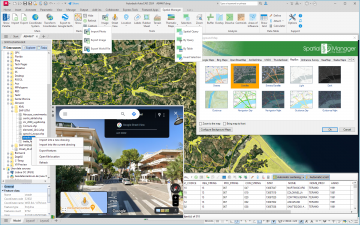Spatial Manager™ for AutoCAD
Introduction
Spatial Manager™ for AutoCAD is a powerful AutoCAD plug-in designed for AutoCAD users who need to import, export and manage spatial data in a simple, fast and inexpensive way, which includes many possibilities not seen so far in AutoCAD. It comes in a lightweight application that runs inside AutoCAD and allows the user to import and export geospatial data between AutoCAD drawings and geospatial files, data servers or data stores
Notes:
- The access to spatial data servers and stores is available on the "Standard" and "Professional" editions only
- The Export function is available on the "Professional" edition only
AutoCAD commands
This is the list of AutoCAD commands included in Spatial Manager™ for AutoCAD
- SPM (or SPATIALMANAGER): Palette. Opens and/or displays the application palette
- SPMIMPORT (or SPATIALMANAGERIMPORT): Import. Directly Imports features from geospatial files or tables without using the application Palette
- SPMEXPORT (or SPATIALMANAGEREXPORT): Export. Exports AutoCAD objects into geospatial files or tables ("Professional" edition only)
- SPMCLOSE (or SPATIALMANAGERCLOSE): Close palette. Closes the application palette
- SPMHELP (or SPATIALMANAGERHELP): Help. Shows the application help (Wiki format)
- SPMABOUT (or SPATIALMANAGERABOUT): About. Shows basic information about the application and the installed release
- SPMUPDATE (or SPATIALMANAGERUPDATE): Update. Checks if there is a new application release to be downloaded from Internet
- SPMOPTIONS (or SPATIALMANAGEROPTIONS): Options. Set of parameters to configure the application (includes also the functionality of SPMUPDATE and SPMABOUT)
- _OPTIONS (AutoCAD native command): Options. New "Spatial Manager" tab including the set of parameters to configure the application (same functionality as above)
Main features
- General
- Import/export spatial data into/from AutoCAD drawings
- Transformation of coordinates when importing or exporting
- XDATA / Extended Entity Data (EED) viewer palette
- Import processes
- Objects imported into a new or open drawing
- Basic target layer or new target layers using a field value
- Use blocks for points and centroids
- Block insertion parameters from field values
- Polygon fills and transparencies
- Polygon centroids
- Elevation and thickness from field values
- Import data from tables as XDATA / Extended Entity Data (EED)
- Speed up the processes skipping some wizard steps
- Launch import processes from the intuitive palette or from the quick import function
- Export processes
- Objects exported to geospatial files or tables in files, servers or stores
- Select objects to be exported or choose a layer or the whole drawing
- Option to treat the closed polylines as polygons when exported
- Automated geometric operations needed to fit the target data format
- Automatic filtering of unsupported objects
- Data sources
- Manage your own shortcuts
- Access to spatial data files (SHP, GPX, KML, OSM, PBF, MIF/MID, TAB, E00, SQLite, SDF, ASCII points, etc.) (see current available Providers)
- Manage your User Data Sources
- Access to spatial database servers (SQL Server, PostGIS, etc.) (see current available Providers)
- Access to other connections (WFS, ODBC points or WKB - Excel, Access, dBase,...-, etc.) (see current available Providers)
Notes:
- The access to spatial data servers and stores is available on the "Standard" and "Professional" editions only
- XDATA / Extended Entity Data (EED) are available on the "Standard" and "Professional" editions only
- The Export function is available on the "Professional" edition only
To get a first preview of the application, please watch this video:
FAQs
Here you will find all the technical information available on the implementation as well as tutorials, additional data, etc.
- How to Start?
- Licenses
- Compatible AutoCAD applications
- Providers
- Interface
- Data sources
- Spatial files
- Databases
- Import
- Export ("Professional" edition only)
Links
Here you will find some useful links to other pages of Spatial Manager™ for AutoCAD
